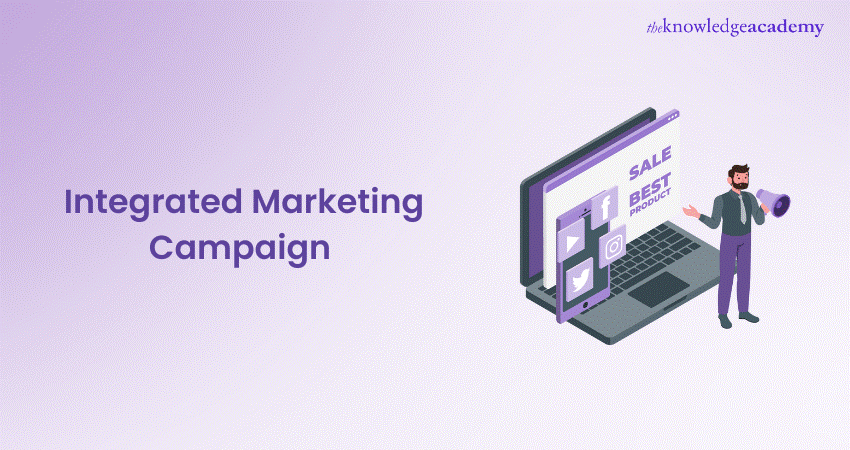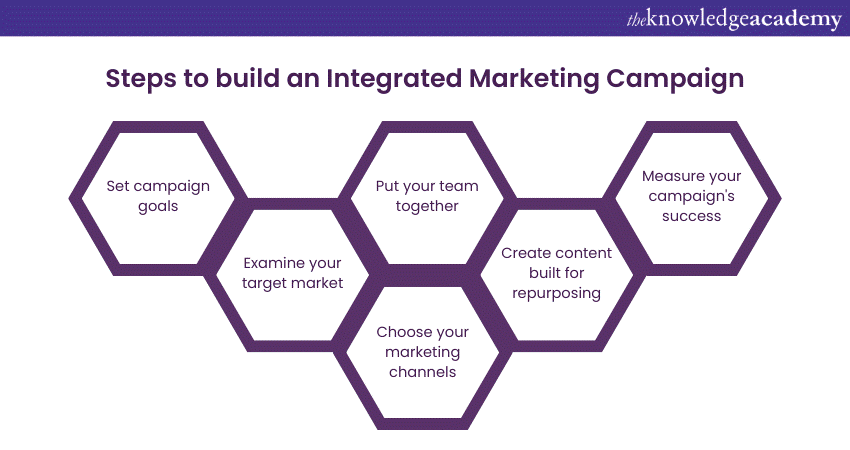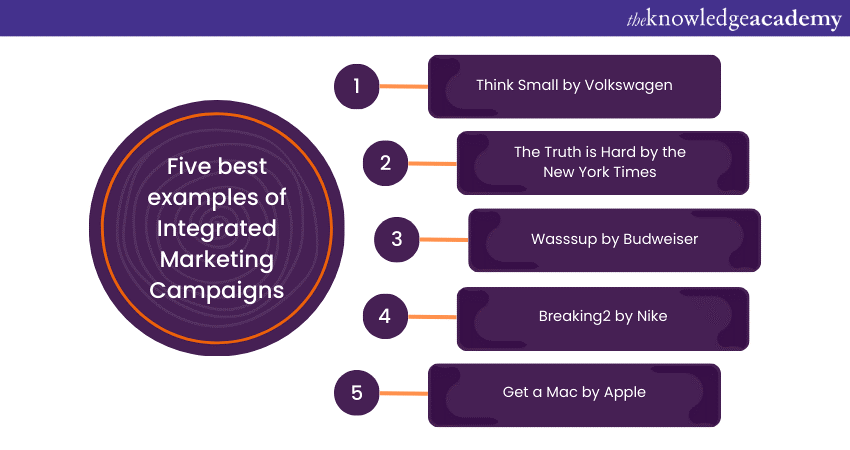We may not have the course you’re looking for. If you enquire or give us a call on 01344203999 and speak to our training experts, we may still be able to help with your training requirements.
Training Outcomes Within Your Budget!
We ensure quality, budget-alignment, and timely delivery by our expert instructors.

Marketing is one of the most important aspects of any business. It helps to attract customers, build brand awareness, and increase sales. However, there are many channels, platforms, and strategies to choose from, and it can be hard to know which ones work best for your business and your audience. That's where Integrated Marketing Campaigns come in.
Integrated Marketing Campaigns can help you achieve your marketing goals, increase your return on investment, and stand out from the crowd. If you want to learn more about it, this blog is for you.
In this blog, you will learn what an Integrated Marketing Campaign is, its advantages, how to build one, and its best examples. Let's get started!
Table of Contents
1) What is an Integrated Marketing Campaign?
2) Advantages of Integrated Marketing Campaigns
3) Steps to build an Integrated Marketing Campaign
4) Five best examples of Integrated Marketing Campaigns
5) Conclusion
What is an Integrated Marketing Campaign?
An Integrated Marketing Campaign is a marketing strategy that uses multiple channels and platforms to deliver a dependable and unified message to a specific audience. The channels and platforms can include traditional media, digital media, and experiential media. The message can be about a product, a service, a brand, or a cause.
The main idea behind an Integrated Marketing Campaign is to create a seamless and harmonious experience for the customer, regardless of where and how they encounter the message. The message should be relevant, engaging, and persuasive, conveying the same core values and benefits across all channels and platforms. The message should also be tailored to each channel and platform's specific characteristics and preferences to maximise its impact and effectiveness.
Advantages of Integrated Marketing Campaigns
Integrated Marketing Campaigns have many advantages over traditional or isolated marketing Campaigns. Let's explore some of its advantages:

1) Brand awareness: They increase brand awareness and recognition by exposing the customer to the same message multiple times, in different ways and contexts. This helps to create a strong and consistent impression of the brand in the customer’s mind and to increase the likelihood of the customer recalling and recognising the brand when they need or want it. Brand awareness and recognition are important for building brand equity and loyalty and influencing the customer’s purchase decision and behaviour.
2) Customer retention: They increase customer loyalty and retention by creating a strong and positive association between the customer and the brand and reinforcing the brand’s identity and personality. This helps to establish a long-term and emotional relationship with the customer and to make the customer feel valued and satisfied with the brand. Customer loyalty and retention are important for increasing lifetime value and profitability and reducing customer churn and acquisition costs.
3) Customer satisfaction: They increase customer satisfaction and trust by delivering a consistent and reliable message that matches customer expectations and needs and reduces confusion and ambiguity. This helps to enhance the customer’s perception and evaluation of the brand’s quality and credibility and to make the customer feel confident and comfortable with the brand. Customer satisfaction and trust are essential for increasing customer advocacy and referrals and reducing customer complaints and negative word-of-mouth.
4) Conversion: They increase customer engagement and conversion by providing the customer with multiple opportunities and incentives to interact with the brand and by creating a sense of urgency and relevance. This helps to capture the customer’s attention and interest and to motivate the customer to take action and to buy the brand’s products or services. Customer engagement and conversion are important for increasing sales and revenue and enhancing customer loyalty and retention.
They increase marketing efficiency and effectiveness by optimising the use of resources and budget and by measuring and evaluating the performance of each channel and platform and the overall campaign. This helps to improve the return on investment and the profitability of the marketing activities, as well as to find and address the strengths and weaknesses of the campaign. marketing efficiency and effectiveness are important for achieving the marketing goals and objectives and improving the marketing strategy and tactics.
Learn the basics of marketing with our Introduction to marketing Training – Sign up today!
Steps to build an Integrated Marketing Campaign
Building an Integrated Marketing Campaign can help your business greatly. But how to build one? What are the steps involved? Let's find out the steps involved:

Step 1) Set campaign goals
The first step is to define what you want to achieve with your Integrated Marketing Campaign. You need to specify your marketing objectives, such as increasing sales, awareness, or loyalty. You must also identify your target audiences, such as their demographics, psychographics, and behaviours.
You also need to determine how you want your audience to perceive your brand and how you want them to respond to your message. Finally, you need to decide how to measure your success by using metrics like reach, impressions, clicks, conversions, or return on investment.
Step 2) Examine your target market
The second step is to understand your target market and audience. You need to research their needs, wants, problems, and aspirations and how your brand can solve them. You also need to analyse their decision-making process, information sources, and media consumption habits.
You must also segment your target market and audience into different groups based on their characteristics and preferences and prioritise the most valuable and profitable segments. You also need to position your brand in a way that differentiates it from your competitors and communicates your unique value proposition.
Step 3) Choose your marketing channels
The third step is to select the most appropriate and effective marketing channels and platforms for your Integrated Marketing Campaign. You need to consider your campaign goals and budget and choose the channels and platforms to help you achieve them within your resources.
Consider your target market and message, and choose the channels and platforms that can reach them and deliver your message effectively. You must also balance and integrate your channel and platform mix and create synergy and complementarity among them. You also need to avoid duplication and cannibalisation of your message and audience.
Step 4) Put your team together
The fourth step is assembling your team of experts and collaborators to help you execute your Integrated Marketing Campaign. You must consider your team size and structure and organise and coordinate your team members according to their roles and responsibilities. You must also consider your team skills and expertise and recruit and train your team members according to their strengths and weaknesses.
You also need to consider your team's communication and collaboration and use the tools and methods that can facilitate them. You also need to manage conflicts and feedback among your team members.
Step 5) Create content built for repurposing
The fifth step is to create content built for repurposing and adaptation across different channels and platforms. You need to consider your content strategy and define your content's purpose, goal, message, value proposition, tone, and style. You also need to align your content with your brand identity and personality. Using strategies like Video marketing Strategy can help deliver your message seamlessly.
Moreover, you also need to consider your content format and choose the type and format of your content, such as text, image, video, or audio. Try to adapt your content to each channel and platform's specific characteristics and requirements. You must also consider your content distribution and plan when, where, and how often you will publish your content. You must also enhance your content for search engines and social media algorithms and promote and amplify your content.
Step 6) Measure your campaign's success
The sixth and final step is to measure and assess the success and impact of your Integrated Marketing Campaign. You need to consider your campaign metrics and use the metrics and indicators to measure your campaign performance and results. You also need to align your metrics with your campaign goals and objectives. You also need to collect and analyse the data from your campaign using various methods like Integrated Marketing Mix. You also need to consider your campaign insights and derive the insights and learnings from the data.
You also need to interpret and communicate your insights and use them to improve your campaign and your future campaigns. You also need to consider your campaign optimisation and optimise and adjust your campaign based on the data and insights. You must also test and experiment with different variations and options, scaling and replicating your campaign's success
Improve your marketing prowess with our marketing Training – Sign up today!
Five best examples of Integrated Marketing Campaigns
From mom-and-pop stores to mighty business empires like Apple, Integrated Marketing Campaigns are among the key reasons for their success. Let's explore the five best examples of Integrated Marketing Campaigns:

1) Think Small by Volkswagen
This campaign promoted the Beetle car in the US market in the 1960s using a minimalist design and a humorous copy to highlight its small size and fuel efficiency. The campaign appealed to post-war consumers who wanted something different and authentic, and it made the Beetle a symbol of the brand and the message.
The campaign was executed across print, TV, radio, and outdoor media, increasing Volkswagen's sales and market share. It is considered one of the best and most influential advertising campaigns of all time.
2) The Truth is Hard by the New York Times
This campaign reaffirmed the commitment and relevance of The New York Times to journalism in the age of fake news and conspiracy theories in 2017. The campaign used a striking design and a compelling copy to highlight the importance and the difficulty of pursuing and reporting the truth. The campaign appealed to the public, who wanted something trustworthy and credible, and it showcased the rigorous and in-depth journalism of The New York Times.
The campaign was executed across TV, print, digital, social, and outdoor media, increasing the subscriptions and revenue of The New York Times. It is considered one of the best and most relevant marketing Campaigns of recent times.
3) Wasssup by Budweiser
This campaign promoted the beer brand and connected with the young and male target market in 1999 by featuring a group of friends who greeted each other by saying “Wassup” in a funny way while drinking Budweiser. The campaign used a catchy design and a memorable copy to highlight the fun and friendship that Budweiser can bring.
The campaign appealed to the audience who wanted something entertaining and social, making the “Wassup” catchphrase a popular and iconic expression. The campaign was executed across TV, radio, print, digital, and outdoor media, and it increased Budweiser's sales and market share. It is considered one of the best and most entertaining marketing Campaigns of all time.
4) Breaking2 by Nike
This campaign showcased the innovation and leadership of Nike in the sports industry and motivated its consumers to achieve their goals in 2017 by featuring three marathon runners who attempted to break the two-hour barrier wearing Nike’s new shoes. The campaign used a sleek design and a motivational copy to highlight the performance and the potential of Nike’s products and athletes.
The campaign appealed to sports enthusiasts and the public who wanted something inspiring and empowering, inviting them to join and support the runners in various ways. The campaign was executed across TV, digital, social, and experiential media, and it increased the awareness and the demand for Nike’s products. It is considered one of the best and most inspiring marketing Campaigns of recent times.
5) Get a Mac by Apple
This campaign promoted the Mac computers and differentiated them from the Windows PCs in 2006, by featuring two characters who represented Mac and PC, played by actors Justin Long and John Hodgman. The campaign used a simple design and a sarcastic copy to highlight the advantages of Mac over PC, such as its ease of use, reliability, security, and compatibility.
The campaign appealed to the tech-savvy and creative audience who wanted something superior and stylish, and it demonstrated and discussed the features and functions of the Mac computers and the Apple software and services. The campaign was executed across TV, print, digital, and outdoor media, and it increased the sales and market share of Mac computers. It is considered one of the best and most witty marketing Campaigns of all time.
Conclusion
We hope you read and understand everything about Integrated Marketing Campaigns. They are a powerful and effective marketing method for your business and brand. They can help you increase your return on investment, achieve your marketing goals, and stand out from the crowd.
Revolutionise your marketing strategy with our Integrated Marketing Masterclass – Sign up now!
Frequently Asked Questions
Upcoming Digital Marketing Resources Batches & Dates
Date
 Integrated Marketing Training
Integrated Marketing Training
Fri 3rd Jan 2025
Fri 7th Mar 2025
Fri 2nd May 2025
Fri 4th Jul 2025
Fri 5th Sep 2025
Fri 7th Nov 2025







 Top Rated Course
Top Rated Course



 If you wish to make any changes to your course, please
If you wish to make any changes to your course, please


